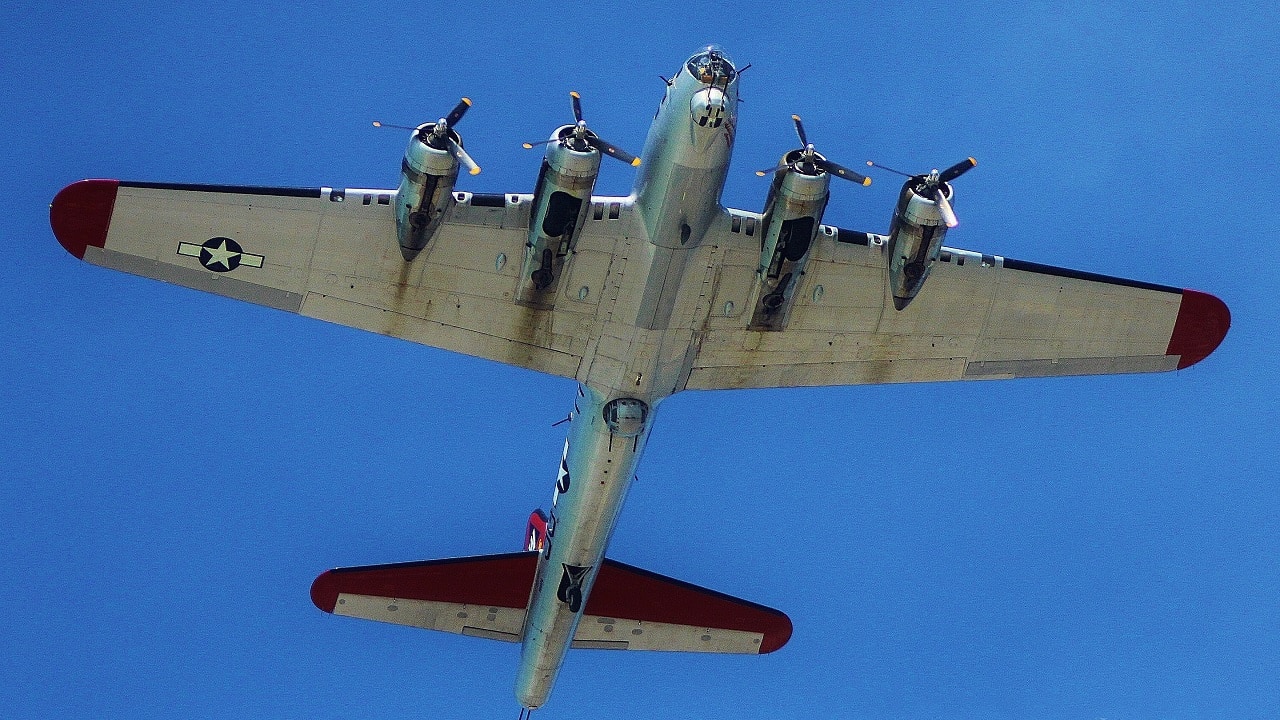Developed for the United States Army Air Corps (USAAC) in the 1930s, the Boeing B-17 was primarily employed during the Second World War as part of the daylight strategic bombing campaign against German industrial, military, and civilian targets. Today, it is arguably one of the most famous aircraft ever built, and one of the most important bombers in history.
Notable B-17 Bomber Facts:
First U.S. Combat Loss of the War
A dozen B-17 Flying Fortresses were on their way to Pearl Harbor on the morning of December 7, 1941 when they came under attack from Japanese A6M “Zero” fighters – one of those bombers was shot down, becoming the first American combat loss of the conflict. One other was damaged on landing.
Those were not the only B-17s to be lost that day. At least half of the thirty B-17s on the ground at Pearl Harbor were also damaged beyond repair. An additional 30 were wrecked on the ground in the Philippines on the same day.
Used in Every Theater of Operations
The B-17 proved to be a versatile aircraft and was used in every theater of World War II, but won immortality for their role in the epic daylight battles against the Luftwaffe. Tragically, more than 47,000 U.S. 8th Air Force crewmen were killed in those daylight raids over Germany.
The B-17 played a crucial role in transforming the United States Army Air Force into the devastating, destructive power it became in the latter stages of the war. At the height of the war in Europe, B-17s occupied more than 25 airfields in the south and east of England.
Truly Young Men
The men who flew the bombers in the combat operations were truly of the “Greatest Generation,” and it was rare that a B-17 pilot was older than 30. In fact, most of the men who took the big bombers into the skies over Germany were barely in their 20s!
The normal crew complement was nine, but occasionally eight or 10. The bombardier was in the extreme nose, while the pilots were seated side-by-side with dual controls. The radio operator’s position was midship, while gunners were located in the two turrets, in “waist” positions on either side of the fuselage and in the extreme tail.
Quite the Sight
The Norden bombsight with which the B-17 Flying Fortress was equipped was considered the best in the world. It was even reputed to be able to “drop a bomb into a pickle barrel” from 13,125 feet (4,000 meters).
The “Big Ass” Model
Among the notable variants to see service was the B-17E, which entered service in September 1941. It was dubbed the “Big Ass” model, as it appeared with an extensively modified empennage. In place of the shark, fin tail was a great dorsal fin that rose just aft of the radio operator’s position, resulting in a sturdy tail.
The crew of one B-17F bomber – the “All American” – was certainly fortunate that the upgrade had occurred, as the aircraft had its tail clipped after a collision with a Messerschmitt Bf 109.
Flying Bomb!
In addition to being a bomber, one variant of the B-17 Flying Fortress was actually that of a flying bomb. About twenty-five of the war-weary B-17s were converted into radio-controlled BQ-7 flying bombs in 1944. Carrying 20,000 pounds (9,070 kg) of explosives and enough fuel for a range of 350 miles, the bombers were taken-off by a two-man crew that would hand over radio control to another B-17, and would then parachute out.
Between August 4, 1944, and January 1, 1945, fifteen BQ-7s were used against German targets – but to little effect.
Not the Most-Produced Bomber of WWII
While the B-17 may be the most famous bomber of the Second World War, it wasn’t the bomber that was produced in the largest number. A total of 12,731 B-17s were produced while 18,482 Consolidated B-24 Liberator bombers were built by the end of the war. However, both heavy bombers still developed a well-earned reputation for being the workhorses of the USAAF.
Today, there are reported to be forty-six surviving B-17s, of which thirty-nine are in the United States. Ten are airworthy. Among the most famous is the “Memphis Belle,” which is currently on display at the National Museum of the United States Air Force.
Now a Senior Editor for 1945, Peter Suciu is a Michigan-based writer who has contributed to more than four dozen magazines, newspapers and websites. He regularly writes about military hardware, and is the author of several books on military headgear including A Gallery of Military Headdress, which is available on Amazon.com. Peter is also a Contributing Writer for Forbes.

